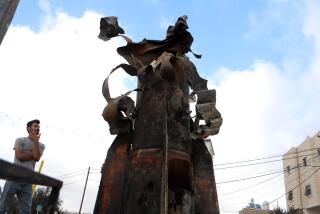Keep the Nuclear Sword Sharp
- Share via
In the post-Sept. 11 world, we know our enemies are as inventive as they are implacable, apparently willing to use any weapon they can get their hands on. The question is whether nuclear weapons--the weapons that safeguarded U.S. national security for the past half a century--remain relevant against these new threats.
As a hedge against surprises, many factors continue to make our nuclear arsenal relevant.
The first is deterrence. The Soviet Union is gone but nuclear weapons continue to exist. Proliferation has continued, and deterrence still matters in a world in which adversaries have shown that they are willing to engage in massively destructive attacks. The U.S. will need a robust deterrent to impress upon any adversary the certainty that launching a nuclear attack on the U.S. or its forces will elicit a devastating return strike.
A second factor is dissuasion. A robust nuclear arsenal can cast a long shadow.
Former Secretary of State James Baker recounts in his memoirs that at a critical moment on the eve of Desert Storm, he delivered a measured message to Iraq’s foreign minister: If Iraq employed its biological or chemical weapons against U.S. forces, “the American people will demand retribution, and we have the means to exact it.” Although Iraq possessed chemical and biological weapons, neither were loaded atop the Scud missiles that Saddam Hussein launched during the conflict. If nuclear dissuasion worked in the Gulf War, its efficacy today against chemical or biological warfare is, if anything, more important.
Third, we must remember that lower stockpiles are not always safer. Lower levels could themselves be destabilizing.
We need to maintain sufficient nuclear numbers--deployed and diversified in sufficiently survivable modes--to convince any nuclear-armed adversary of any size that it cannot hope to prevail or profit from using or even threatening to use its weapons against us.
There is no magic number of nuclear weapons that gives us such a guarantee. Yet that is all the more reason to proceed with caution as we cut from 7,000 weapons today to 2,200 a decade from now. Both the U.S. and Russia may want to preserve the ability to reassess the threats we face and revisit the question of how low we can go with nuclear arms cuts.
Fourth, the nuclear triad concept remains viable.
Our dual-capable bombers have unique flexibility. Our Trident submarines are the original survivable stealth platforms. Intercontinental ballistic missiles provide an accurate, prompt response capability, deployed in hardened silos in a way that contributes to stability by making it impossible to destroy our strategic capabilities with a limited attack.
The cost savings from eliminating any leg of the nuclear triad would be far outweighed by loss in capabilities and stability.
Finally, the stewardship of nuclear stockpiles is critical. Since the mid-1990s, most nuclear powers have been engaged in an unprecedented attempt to sustain deterrence without nuclear testing. The current stockpiles have been certified safe and reliable. Yet there are some signs of deterioration, and a decision has been made to remanufacture the weapons over the next 10 to 15 years. This will require a substantial investment to upgrade the condition and capability of the production complex, and an effort to attract and train the individuals responsible for design maintenance and production of our nuclear weapons.
For all the uncertainties our world presents, this much is certain: The world will be a safer place with the continued existence of an ample U.S. nuclear arsenal.
*
John Foster, chairman of the independent Panel to Assess the Reliability, Safety and Security of the U.S. Stockpile, is the former director of the Livermore Laboratory and the Defense Department’s former director of defense research and engineering.
More to Read
Sign up for Essential California
The most important California stories and recommendations in your inbox every morning.
You may occasionally receive promotional content from the Los Angeles Times.












